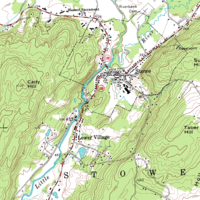
Photo from wikipedia
The ability to model morphological changes on complex, multi-landform coasts over decadal to centennial timescales is essential for sustainable coastal management worldwide. One approach involves coupling of landform-specific simulation models… Click to show full abstract
The ability to model morphological changes on complex, multi-landform coasts over decadal to centennial timescales is essential for sustainable coastal management worldwide. One approach involves coupling of landform-specific simulation models (e.g. cliffs, beaches, dunes and estuaries) that have been independently developed. An alternative, novel approach explored in this paper is to capture the essential characteristics of the landform-specific models using a common spatial representation within an appropriate software framework. This avoid the problems that result from the model-coupling approach due to between-model differences in the conceptualizations of geometries, volumes and locations of sediment. In the proposed framework, the Coastal Modelling Environment (CoastalME), change in coastal morphology is represented by means of dynamically linked raster and geometrical objects. A grid of raster cells provides the data structure for representing quasi-3-D spatial heterogeneity and sediment conservation. Other geometrical objects (lines, areas and volumes) that are consistent with, and derived from, the raster structure represent a library of coastal elements (e.g. shoreline, beach profiles and estuary volumes) as required by different landform-specific models. As a proof-of-concept, we illustrate the capabilities of an initial version of CoastalME by integrating a cliff–beach model and two wave propagation approaches. We verify that CoastalME can reproduce behaviours of the component landform-specific models. Additionally, the integration of these component models within the CoastalME framework reveals behaviours that emerge from the interaction of landforms, which have not previously been captured, such as the influence of the regional bathymetry on the local alongshore sediment-transport gradient and the effect on coastal change on an undefended coastal segment and on sediment bypassing of coastal structures.
Journal Title: Geoscientific Model Development
Year Published: 2017
Link to full text (if available)
Share on Social Media: Sign Up to like & get
recommendations!